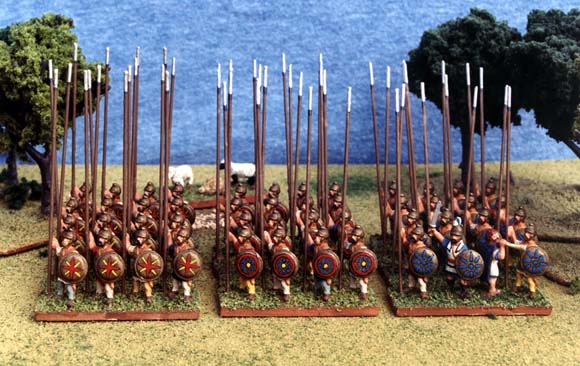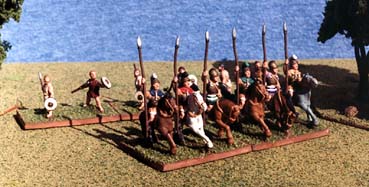
It is hard not to get caught up in the romanticism of Alexander the Great's career and life. I was captivated by the novels of the late Mary Renault, which to me, are peerless in their protrayal of Alexander and his companions and contemporaries. Probably my favorite is "Funeral Games," which begins with Alexander's death in Babylon and the intrigues and wars of his Successors. An excellent non-fiction source is the extensive "Alexander to Actium" by Peter Green. No wargamer interested in this era should be without it.
Alexander and his successors' armies were incredibly efficient, veteran troops. They featured an array of troop types, the core of which were the pike phalanx and the companion cavalry. These were often used as the "hammer and anvil" by Alexander, who I believe, was likely the greatest general in history.

The Macedonian pike phalanx was a fearsome war machine, and one that even the Romans (who faced a degraded version of it) admitted was an awesome sight. Alexander's veterans were well drilled and capable of wearing down any opponent, whether mounted or foot.
I used Essex Miniatures "Eastern Phalangite" as my pikemen because I wanted to replace the lead pike with a piano wire one (brass wire works equally well, and is probably easier on your wire cutters!). I chose this pose because the pike was attached only at two points -- the hand and the base, which made it easy to cut out and replace with a wire shaft. Also, the pike is being held upright rather than levelled, which prevents problems lining up troops on the tabletop. I was really happy with how these guys turned out.

The nobility of Macedon often fought as mounted heavy cavalry armed with what we now call a lance. Since they did not have stirrups, they used the lance two handed, which prevented them from using a shield. This did not keep the Companions, as Alexander's elite cavalry were called, from charging right in against enemy infantry. Time and again in battles throughout Alexander's career, the Companions broke the enemy with their charge. Alexander, the prototype bold general, often fought in the front ranks of the Companions, being wounded numerous times in his career.